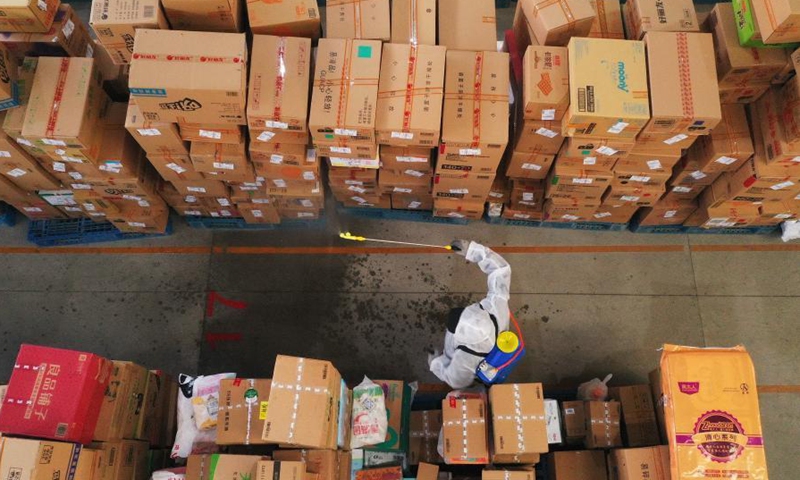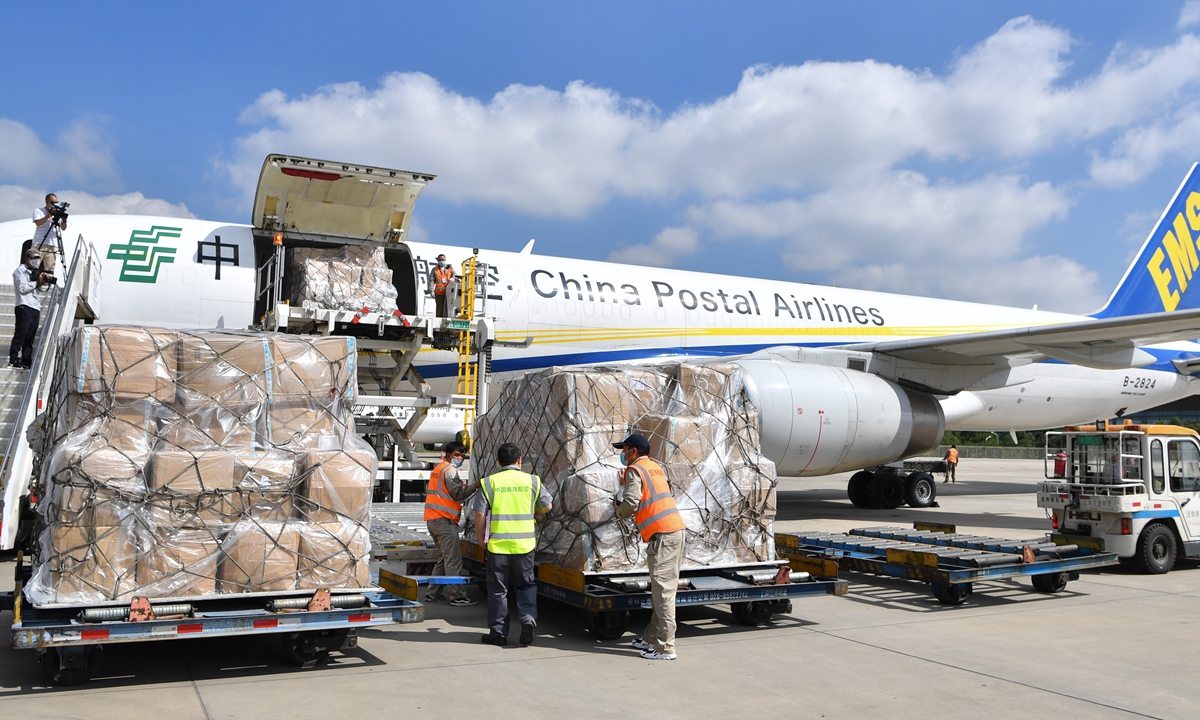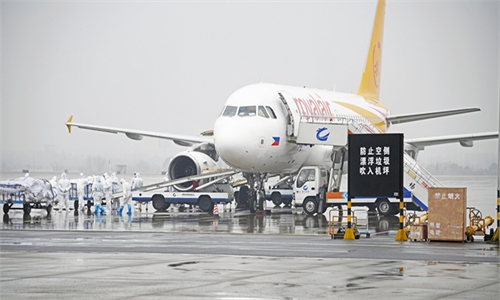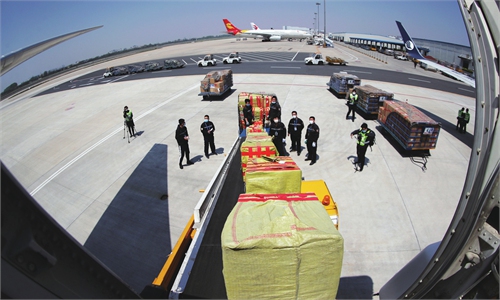Airlines open new routes and increase cargo flight frequency between China and SE Asia

Aerial photo taken on Jan. 23, 2021 shows a staff of Shijiazhuang distribution center of Cainiao Network, the logistics platform of e-commerce giant Alibaba, disinfecting packages in Shijiazhuang, north China's Hebei Province. (Xinhua/Mu Yu)
A number of domestic and foreign airlines are busy opening new routes and increasing cargo flight frequency between Southern China, and Southeast Asia to strengthen connectivity and cope with rising logistics demand.
We are witnessing a surge in cross-border logistics volume from China to Southeast Asia, Cainiao Network said in a note to the Global Times on Wednesday, adding that Alibaba's e-commerce platforms in Southeast Asia, such as Lazada, Taobao and Tmall, have all experienced sharp growth in demand.
In Malaysia, we have also launched a thrice per week direct air freight service from China to East Malaysia to boost Lazada's cross-border logistics efficiency and reduce costs by over 50 percent for Sabah and Sarawak customers. This will also shorten average delivery time by two days, from 14 to 12 days or as fast as seven days, Cainiao added.
We are increasing the transport capacity in Southeast Asia, including replacing large aircraft, cargo giant SF International said in a note to Global Times on Wednesday, explaining that e-commerce deliveries and electronic products represented the bulk of the year end transport demand.
The airlines are not alone. Take Kunming Changshui International Airport in Southwest China's Yunnan Province as an example, the airport's international cargo market has witnessed booming growth. It is estimated that nearly 20 international cargo flights will be added every week, with nearly 800 tons of international cargo and mail awaiting transport every seven days, according to Chinanews.cn on Tuesday.
The new routes include Kunming to Jakarta by Garuda Indonesia, Thai VietJet Air's Kunming-Bangkok passenger-to-cargo route, and Cambodia Airlines' Kunming-Phnom Penh passenger-to-cargo route.
In addition, YTO Airlines and Spice Jet both increased the frequency of all-cargo routes from Kunming airport in December.
Market watchers attributed the rising demand to the gradual reopening of Southeast Asian countries, which has pushed up the demand for materials due to factories coming back offline.

A plane from China Postal Airlines at Kunming airport in Southwest China's Yunnan Province in June of 2020 Photo: cnsphoto
The high demand during the Black Friday and Christmas export seasons from the third quarter has also placed vendors serving trans-Pacific cargo routes in high demand, resulting in tight supply for short-haul routes, another reason behind the rise in cargo shipping, as well as the cargo air transport.
Cathay Pacific said in a release sent to the Global Times that cargo figures in November was one of their strongest ever cargo peak periods, as expected.
Air cargo demand has been consistently robust across many regional markets. In addition to underlying air cargo demand remaining strong, Cathay Pacific also carried products that would usually be shipped by sea as retailers looked to replenish low inventories to meet customer demand. Inbound demand to the hub was also healthy as seasonal products, such as Beaujolais wine from France to Japan and cherries from the Southern Hemisphere to Asia, were shipped throughout the month, according to Cathay Pacific.
In recent years, with the adjustment of China's industrial structure, high labor costs and the appreciation of the yuan, foreign trade orders "flying southeast" have become a growing trend. However, during the epidemic, the return of large quantities of orders to China has become one of the driving forces of China's double-digit growth in foreign trade, also reinforcing the resilience and competitiveness of China's supply chains.
The pandemic has changed consumer behavior and increasingly shifted them online to satisfy their daily purchasing needs. This led to a consistent growth in e-commerce logistics demand and we foresee that this behavior will continue to persist in the near to long term, Cainiao added.
In a report released by FedEx Express, a subsidiary of FedEx Corp on December 7 showed that the Asia Pacific, Middle East and Africa region will be at the forefront of e-commerce growth for many years to come.
"With rising disposable incomes, growing internet penetration and emerging cross-border e-commerce markets, there is a huge amount of growth yet to be realized here," said Kawal Preet, president of the Asia Pacific, Middle East and Africa region at FedEx Express.
China's imports and exports surged 22 percent year-on-year over the first 11 months this year to reach 35.39 trillion yuan ($5.55 trillion), exceeding the level of trade volume seen last year (32.16 trillion yuan) thanks to better than expected performance in November, data from China Customs revealed.
ASEAN maintained its position as China's largest trading partner, with a trade value hitting $789.53 billion, an increase of 29.8 percent.
Cainiao said by working collaboratively with local and cross-border logistics partners, ranging from first and last mile, warehousing, line haul to customs clearance, they were able to leverage the smart logistics network to achieve full-chain visibility of the parcels, determine available resources and assets for deployment, and maximize utilization by tapping on AI algorithms and big data.



